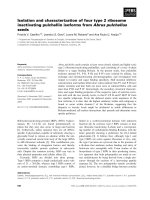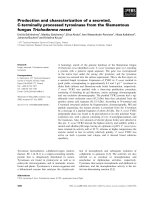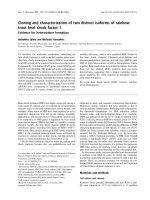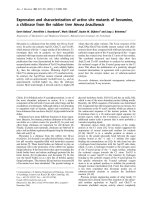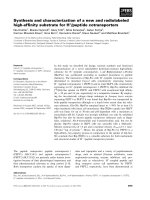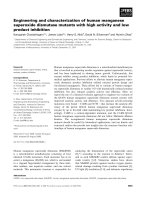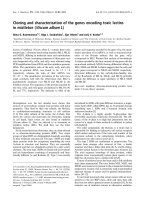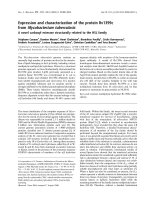Báo cáo y học: " Generation and characterization of high affinity human monoclonal antibodies that neutralize staphylococcal enterotoxin B" ppsx
Bạn đang xem bản rút gọn của tài liệu. Xem và tải ngay bản đầy đủ của tài liệu tại đây (426.74 KB, 9 trang )
ORIGINAL RESEARCH Open Access
Generation and characterization of high affinity
human monoclonal antibodies that neutralize
staphylococcal enterotoxin B
Brian Drozdowski
1
, Yuhong Zhou
1
, Brad Kline
1
, Jared Spidel
1
, Yin Yin Chan
1
, Earl Albone
1
, Howard Turchin
1
,
Qimin Chao
1
, Marianne Henry
1
, Jacqueline Balogach
1
, Eric Routhier
1
, Sina Bavari
2
, Nicholas C Nicolaides
1
,
Philip M Sass
1
, Luigi Grasso
1*
Abstract
Background: Staphylococcal enterotoxins are considered potential biowarfare agents that can be spread through
ingestion or inhalation. Staphylococcal enterotoxin B (SEB) is a widely studied superantigen that can directly
stimulate T-cells to release a massive amount of proinflammatory cytokines by bridging the MHC II molecules on
an antigen presenting cell (APC) and the Vb chains of the T-cell receptor (TCR). This potentially can lead to toxic,
debilitating and lethal effects. Currently, there are no preventative measures for SEB exposure, only supportive
therapies.
Methods: To develop a potential therapeutic candidate to combat SEB exposure, we have generated three human
B-cell hybridomas that produce human monoclonal antibodies (HuMAbs) to SEB. These HuMAbs were screened for
specificity, affinity and the ability to block SEB activity in vitro as well as its lethal effect in vivo.
Results: The high-affinity HuMAbs, as determined by BiaCore analysis, were specific to SEB with minimal
crossreactivity to related toxins by ELISA. In an immunoblotting experiment, our HuMAbs bound SEB mixed in a
cell lysate and did not bind any of the lysate proteins. In an in vitro cell-based assay, these HuMAbs could inhibit
SEB-induced secretion of the proinflammatory cytokines (INF-g and TNF-a) by primary human lymphocytes with
high potency. In an in vivo LPS-potentiated mouse model, our lead antibody, HuMAb-154, was capable of
neutralizing up to 100 μg of SEB challenge equivalent to 500 times over the reported LD
50
(0.2 μg) , protecting
mice from death. Extended surviv al was also observed when HuMAb-154 was administered after SEB challenge.
Conclusion: We have generated high-affinity SEB-specific antibodies capable of neutralizing SEB in vitro as well as
in vivo in a mouse model. Taken together, these results suggest that our antibodies hold the potential as passive
immunotherapies for both prophylactic and therapeutic countermeasures of SEB exposure.
Introduction
Staphylococcus aureus is a Gram-positive bacterium
responsible for skin, soft-tissue, respiratory, bone, joint,
and endovascular disorders, and has potentially lethal
effects due to endocarditis, sepsis, and toxic shock syn-
drome [1]. Virulence for a number of the pathogenic
manifestations of S. aureus is caused by a handful of
toxins produced and secreted by the bacterium, which
include among others t he toxins responsible for toxic
shock syndrome, TSST-1, and S. aureus enterotoxins
(SEs), which cause food poisoning. About twenty entero-
toxinshavebeendescribedthatexhibitandaredefined
by their emetic activity in primates [2-6]. Enterotoxins
are also referred to as superantigens (SAgs) because
they bypass antigen processing by forming a bridge
between the MHC II molecules on an antigen present-
ing cell (APC) and the Vb chain of the T-cell receptor
(TCR) causing a massive release o f cytokines, such as
interferon-gamma (INF-g) and tumor necrosis factor-
alpha (TNF-a). SEB is one of the most studied entero-
toxins notoriously associated with food poisoning
* Correspondence:
1
Morphotek Inc., 210 Welsh Pool Road, Exton, PA, USA
Full list of author information is available at the end of the article
Drozdowski et al. Journal of Immune Based Therapies and Vaccines 2010, 8:9
/>© 2010 Drozdowski et al; licensee BioMed Central Ltd. This is an Open Access article distributed under the terms of the Creative
Commons Attribution License ( enses/by/ 2.0) , which permits unrestricted use, distribution, and
reproduction in any medium, provided the original work is properly cited.
through ingestion. Symptoms include a rapid onset of
fever, intense nausea, vomiting, cramping abdominal
pain, and diarrhea. Most cases are self-limited and
resolve in 8-24 hours. If aerosolized, SEB could cause
severe cases of pulmonary edema and respiratory failure
[7,8]. Since it has the potential to be weaponized and
used as an incapacitating or lethal agent, the National
Institu te of Allergy and Infectious Diseases (NIAID) and
the Centers for Disease Control and Prevention ( CDC)
recognize SEB as a category B agent.
Currently, there are no commercial preventative mea-
sures or therapies for SEB exposure based on passive
(antibodies) or active (vaccines) immunotherapy, despite
the fact that multiple attempts to develop therapies have
met with various degrees of success. SEB mutants gener-
ated by site-directed mutagenesis and lacking superanti-
genic effects are highly immunogenic in mice and
rhesus monkeys, demonstrating their potential as a vac-
cine for prophylactic intervention [9]. Woody et al have
studied the v accine potential of mutan t staphylococcal
SEB proteins and showed that some were able to elicit a
protective antibody response in LPS-potentiated mice
[10]. Strategies aimed at disrupt ing SEs int eraction with
the immune system include low-molecular antagonist
peptides, based on the SEs conserved regions, as well as
soluble T-cell receptor that can sequester SEB [11-14].
The use of mouse monoclonal anti-SEB antibodies to
study important epitope determinants essential for
MHC/TCR binding has led others to explore the use of
anti-SEB antibodies for blocking SEB from engaging the
immune system [15] . Other notable studies have
included a murine toxic shock syndrome toxin 1
(TSST-1)-specific monoclonal antibody (MAb) which
crossreacted to SEB by ELISA and partially inhibited
SEB-induced T-cell mitogenesis as well as TNFa secre-
tion in human PBMCs in a dose-dependent manner in
vitro [16]. Also, LeClaire et al demonstrated the feasibil-
ity of using a passive immunity strategy ut ilizing SEB-
specific MAbs raised in chicken to block SEB-mediated
toxicity in Rhesus monkeys [17]. In this study, animals
(4/4) that received molar ratios of antibody to toxin of
21:1 and 37:1 survived an aerosolized exposure of
approximately 5 LD
50
of SEB.
Pooled human sera with titers against SEs and TSST-1
were reported to suppress in vitro SEB-induced human
T-cell proliferation while affinity purified anti-SEB anti-
bodies from the pooled human sera prophylactically
protected mice from a SEB lethal challenge [18]. More
recently, chimeric mouse-human antibodies with high
affinities for SEB were reported to inhibit SEB induced
proliferation and cytokine production in both human
PBMCs and mouse splenocytes in vitro [19]. In this
report, we detail the generation and selection of fully
human monoclonal antibodies (HuMAbs) specific for
SEB derived from human B-cell hybridomas. These anti-
bodies showed biological activity towards SEB in vitro.
In addition, HuMAb-154, which displayed the highest
anti-SEB affinity, exhibited prophylactic as well as thera-
peutic activity i n a mouse model of SEB- induced
lethality.
Materials and methods
Generation of HuMAbs
Human B- cell hybridomas producing SEB- specific
HuMAbs were generated using Human MORPHO-
DOMA® technology as previously described [20]. Briefly,
leukopacks were obtained from healthy individuals with
anti-SEB serum antibody titers. B cells were isolated
from the PBMC population using an EasySep human B
cell enrichment kit (StemCell Technologies). B cells
were cultured for 7 days in IMDM media (Invitrogen)
supplemented with 10% heat-inactivated FBS (JRH BioS-
ciences), 10 ng/ml human IL-2, 10 ng/ml human IL-10
(PeproTech), 2 mM L-glutamine, 0.1 mM nonessential
amino acids, 1 mM sodium pyruvate, 55 μM 2-mercap-
toethanol (Invitrogen) in the presence of irradiated
CHO feeder cells. Cultured B cells were then electro-
fused with CB-F7 heteromyeloma cells [21] (kind gift
from Dr. Roland Grunow, Robert Koch-Institute) using
the Cyto Pulse CEEF-50 apparatus (Cyto Pulse Sciences)
to generate hybridomas. Individual hybridoma clones
were screened by SEB-specific ELISA (Recombinant
SEB, highly purified, from Toxin Technology, Inc.) for
specific SEB-reactive antibodies. Clones highly reactive
with SEB without crossreactivity to the other unrelated
antigens were subcloned followed by ELISA screening to
confirm retention of SEB specificity. Light and heavy
chain genes of lead clones were sequenced and cloned
for recombinant expression of corresponding antibodies
in CHO cells.
HuMAb ELISA reactivity to related toxins
Related Staphylococcus enterotoxins (SEs), SEB, SEA,
SED, SEC1, TSST-1 (Toxin Technology, Inc.), and teta-
nus toxoid (Cylex Inc.) were diluted to 0.5 μ g/ml in
coating buffer (50 mM carbonate-bicarbonate, pH 9.4)
and coated in microtiter plates overnight at 4°C. Plates
were blocked and ELISA-based screening was performed
as for identification of HuMAbs.
SDS-PAGE and Western blotting
SEB at 500 ng and 20 μg of 293 cell lysates were diluted
in SDS sample buffer then subjected to reducing and
non-reducing SDS-PAGE on a 4 to 12% gradient gel in
MES buffer (NOVEX, San Diego, CA). Electrophoresed
proteins were transferred onto nitrocellulose sheets.
After transfer, the sheets were blocked with TBS con-
taining 5% milk and 0.1% Tween-20 (5% milk/TBS-T)
Drozdowski et al. Journal of Immune Based Therapies and Vaccines 2010, 8:9
/>Page 2 of 9
for 1 hour at room temperature with gentle agitation.
Blots were agitated for 1 hour with HuMAbs at 1 μg/ml
diluted in 5% milk/TBS-T. The blots were then washed
four times (for 5 min each time with agitation) with
TBS containing 0.1% Tween-20 (TBS-T), followed by
gentle agitation for 1 hour at room temperature with
peroxidase-conjugated goat anti-human IgG+M (H+L)
Ab (Jackson Immuno Laboratories) (diluted 1:10,000 in
5% milk/TBS-T). The blots were washed again four
times and the immunoreactive proteins were visualized
using SuperSignal West Femto Luminescent Substrate
(Pierce).
Surface plasmon resonance
SEB was diluted in 10 mM sodium acetate pH 5.5, to a
final concentration of 10 μg/ml and coupled to the sur-
face of a research-grade CM5 chip (Biacore, Inc., Piscat-
away, NJ) by standard amine chemistry (NHS-EDC,
Biacore, Inc.), to a level of 50-250 RU of SEB bound.
The remaining active sites were quenched using 1 M
ethanolamine. A reference flow cell consisting of an
activated and quenched surface in the absence of anti-
gen was created and used to normalize readings from
injections of anti-SEB-containing samples. Purified
HuMAbs were diluted into HBS-EP buffer (Biacore,
Inc.) to final concentrations of 50 nM, 25 nM, 12.5 nM,
6.25 nM, 3.13 nM, 1.56 nM and 0.78 nM. The running
buffer used was HBS-EP with a flow rate of 30 μl/min.
Regeneration of the surface was performed by two injec-
tionsof10mMHClfor30secondsataflowrateof
100 μl/min. The on- (ka) and off-rate (kd) of HuMAbs
were determined by observing the signal over time for
triplicate injections at each concentration above. Blank
injections of HBS-EP were also performed to assess
noise, and to normalize injection data. All samples were
randomly injected for two minutes using the KINJECT
command and the dissociation phase of binding was
observed for 10 minutes. The data were fitted to a biva-
lent analyte binding model, using BiaEvaluation 4.1 soft-
ware (Biacore, Inc.), as no mass transfer effects were
obvious in control experiments. A steady-state binding
constant (K
D1
)wasderivedfromtheobservedon-and
off-rates (k
a1
and k
d1
, respectively) for first-site binding
of antibody to SEB.
In vitro toxin neutralization
Human peripheral blood mononuclear cells (PBMCs)
were used to determine the ability of HuMAbs to inhibit
SEB-induced T-cell cytokine production and measure
their in vitro EC
50
. PBMCs isolated from blood drawn
from healthy volunteers were purified by Ficoll-Paque
Plus (Amersham-Pharmacia). Approximately 1 × 10
5
cells in 100 μl of IMDM medium supplemented with
10% heat-inactivated FBS (JRH Biosciences), 2 mM
L-glutamine, 0.1 mM nonessential amino acids , 1 mM
sodium pyruvate , 55 μM 2-mercaptoethanol (Invitro-
gen), 5 μg/ml gentamicin (Gibco), were cultured in 96-
well flat-bottom tissue culture plates and incubated at
37°C in 5% CO2. Various 4x concentrations of HuMAbs
or combination thereof at different ratios were incu-
bated with SEB (4x its in vitro ED
50
, data not shown)
for 1 h and the mixture subsequently added to the
PBMCs (1x final concentration for both HuMAbs and
SEB). After 18-22 hours, supernatants were transferred
to IFN-g-andTNF-a-coated ELISA plates (75 μl/well)
and assayed using an ELISA kit (R&D System) following
the manufacturer’s recommended procedure. EC
50
cal-
culationsofHuMAbswereperformed using Prism4
(GraphPad Software). The sensitivity limit of the IFN-g
and TNF-a ELISA is 16 pg/ml.
In vivo toxin neutralization
In vivo studies were conducted by TransPharm Preclini-
cal Solutions as well as at US Army Medical Research
Institute for Infectious Diseases. Female Balb/C mice
ordered from Charles River weighing 14-16 g were accli-
mated to housing conditions and handled in accordance
with AUP number TP-06-08. They were 7-8 weeks old
on Day 1 of the experiment. The animals were fed
irradiated Rodent Diet 5053 (LabDiet™ )andwater
ad libitum. Mice were housed in static cages with Bed-
O ’ Cobs™ bedding inside BioBubble® Clean R ooms that
provide H.E.P.A filtered air into the bubble environment
at 100 complete air changes per hour. All challenges
were carried out in the BioBubble environment. The
environment was controlled to a temperature range of
71° ± 4°F and a humidity range of 30-70%. All animals
were observed for clinical signs at least once daily. All
procedures carried out in this experiment were con-
ducted in compliance with all the laws, regulations and
guidelines of the National Institutes of Health (NIH)
and with the approval of the TPPS Animal Care and
Use Committee.
Mice were challenged with various concentrations of
SEB (Toxin Technology, FL) to assess the protective
activity of HuMAb-154 in vivo. The presumptive LD
50
of SEB in Balb/C mice was 0.2 μg/mouse [18]. SEB chal-
lenges of 1, 5, 10, 20, 50, and 100 μgSEB/mousewere
premixed with 500 μg of HuMAb-154 then injected
intraperitoneally. To spare additional animals from an
unnecessary sacrifice, only mice treated with HuMAb-
154 were challenged with SEB doses higher than 5 ug of
SEB. SEB toxicity was potentiated by the administration
of LPS (150 μg/mouse) three hours following the SEB
challenge. Challenge controls were injected with SEB
alone and LPS alone. Survival was determined after
3 days. Time course studies were conducted to assess
the therapeutic activity of a 500 μg dose of HuMAb-154
Drozdowski et al. Journal of Immune Based Therapies and Vaccines 2010, 8:9
/>Page 3 of 9
administered at 0, 0.5 and 1 hr following a challenge of
5 μgand10μg of SEB. An LPS potentiating dose of
150 μg/mouse was delivered three hours following the
SEB challenge. Survival was determined after 4 days.
Statistical methods
Data was analyzed in the Prism software package
(GraphPad Software, Inc). An unpaired two-tailed t-test
was used to analyze in vitro neutralization assays while
in vivo survival curves were analyzed using the Log-rank
(Mantel Cox) test.
Results
Generation of human monoclonal antibodies
targeting SEB
Healthy volunteers whose sera showed pre-existing high
immune reactivity to SEB were identified by ELISA.
B-cells isolated f rom these selected donors’ blood sam-
ples were cultured and expanded using an in vitro cul-
ture system. Expanded B-cells were subsequently fused
to myeloma cells to generate a library of hybridomas.
We screened the conditioned media produced by these
hybridomas by ELISA for reactivity to STEB, an SEB
vaccine which is a recombinant and attenuated form of
SEB [9]. STEB contains site mutations in the hydropho-
bic binding loop, polar binding pocket, and disulfide
loop (L45R, Y89A, and Y94A, respectively) yet retains
its antigenic characteristics [22]. STEB reactive hybri-
doma clones were further screened against SEB as well
as a panel of nonrelated antigens to confirm reactivity
and determine specificity. We t hen subcloned and
rescreened SEB-specific hybridomas by ELISA. Three
hybridomas, HuMAb-79G9, HuMAb-100C9 and
HuMAb-154, met the binding (Figure 1) and selectivity
criteria (data not shown) and were chosen for further
analyses. We d etermined the heavy and light chain
encoding sequences of these three human IgG1 kappa
antibodies and constructed DNA expression vectors that
allowed us to recombinantly expressed HuMAbs in
mammalian cells for large-scale production.
Specificity and binding potency of anti-SEB HuMAbs
Western blotting was used to address whether the
HuMAbs reacted non-specifically to cellular proteins.
Human cell lysates were spiked with SEB, loaded on
SDS-page under reducing and non-reducing conditions,
and then probed with each HuMAb. All three HuMAbs
recognized the 28 kD SEB in the cell lysate without
binding any other cellular protein (Figure 2) demon-
strating the specificity of these HuMAbs.
In addition, we carried out surface plasmon resonance
(SPR) analyses to determine the binding kinetics of each
HuMAb. SEB was immobilized on a CM5 chip followed
by injections at various c oncentrations of HuMAb.
Using a bivalent binding model, we determined steady-
state binding (K
D1
) constants. HuMAb-154 displayed
the strongest affinity (K
D1
of 290 pM) (Table 1). The
different binding strengths measured b y SPR correlated
well with the binding values as determined by antigen-
specific ELISA (Figure 1). Additional SPR analysis using
Figure 1 Binding strength of HuMAbs was tested by ELISA
using microplates coated with SEB. Each point represents the
average of triplicate samples ± the SD and the data shown are
representative of two or more independent experiments.
Figure 2 HuMAb specificity demonstrated by Western blotting .
Human cell lysates (20 μg) spiked with SEB (0.5 μg) were blotted
under reducing and non-reducing conditions then probed with
HuMAbs. HuMAbs bind only SEB within cell lysates without binding
any of the lysate proteins.
Drozdowski et al. Journal of Immune Based Therapies and Vaccines 2010, 8:9
/>Page 4 of 9
a competitive binding format revealed that HuMAb-154
and HuMAb-100C9 shared the epitope or at least have
epitopes in close proximity to one another since
HuMAb-100C9 cannot bind SEB that has been saturated
with HuMAb-154 (data not shown).
HuMAbs neutralize SEB-induced cytokine production by
human lymphocytes
To examine the biological activity of HuMAbs in vitro,a
cell-based assay was employed that measures inhibitory
effects on SEB-induced secretion of proinflammatory
cytokines by human peripheral blood lymphocytes. Pri-
mary human T-cells stimulated with SEB in vitro will
upregulate the secretion of cytokines including INF-g
and TNF-a,whichin vivo mediate SEB toxicity. Secre-
tion levels of these cytokines can be monitored using
INF-g-andTNF-a-specific E LISAs. An irrelevant
human IgG1 had no significant inhibitory activity on
SEB-induced cytokine production whereas HuMAb-
79G9 showed a dose-dependent inhibitory activity
(Figure 3A). In subsequent experiments, it was observed
that each HuMAb could block SEB-induced activation
of human T-cells whereby HuMAb-154 showed the
highest potency (Figure 3B), suggesting a correlation
between high affinity and potency. It was also observed
that HuMAbs alone were not cytotoxic to PBMCs or
induced INF-g and TNF-a secretion as compared to the
medium control (data not shown). To define accurately
Table 1 Binding kinetics of HuMAbs as determined by
surface plasmon resonance
HuMAb k
a1
k
d1
K
D1
(nM)
79G9 9.56E+03 2.39E-04 25.0
100C9 207E+03 11.3E-04 5.46
154 93.2E+03 0.27E-04 0.29
Figure 3 Assessment of HuMAbs in vitro neutralization activity against SEB. A) Dose-dependent cytokine production inhibitory activity of
HuMAb-79G9 as compared to an irrelevant IgG1. Each bar represents the average of triplicate samples ± the SD and the data shown are
representative of two or more independent experiments. At all antibody concentrations for each cytokine, % inhibition by HuMAb-79G9 was
significant (P < 0.05) as compared to % inhibition by an irrelevant hIgG. B) Comparison of dose-dependent cytokine production inhibitory activity
of three lead HuMAbs. Each point on each line represents the average of triplicate samples ± the SD and the data shown are representative of
two or more independent experiments.
Drozdowski et al. Journal of Immune Based Therapies and Vaccines 2010, 8:9
/>Page 5 of 9
the 50% effective dose (EC
50
) of HuMAb-154, several
experiments were conducted using indepe ndent batches
of purified HuMAb-154. Regardless of the batch used,
operator, or the cytokine analyzed, the EC
50
of HuMAb-
154 always remained below 1 ng/mL (Table 2).
Crossreactivity of HuMAb-154 to other bacterial toxins
To test whether HuMAb-154 crossreacted to other bac-
terial toxins, a panel comprising different staphylococcal
toxins (SEA, SEB, SED, TSST-1, and SEC1) and the less
related tetanus toxin (TT) were screened by ELISA.
Toxins were readily detected by the corresponding
toxin-specific control antibodies (Figure 4A), thus con-
firming that all toxins had been efficiently coated on the
ELISA micropl ate. Under these conditions, HuMAb-154
showed the highest reactivity to SEB while having some
cross-reactivity to other enterotoxins (SEA, SED, and
SEC1, Figure 4B) but not to TSST-1 or TT toxins. An
irrelevant human IgG1 did not react with any of the
toxins (Figure 4B) confirming the s pecificity of our
assay. HuMAb-154 reactivity to SEC1 is plausible being
that SEB and SEC1 share a high degree of amino acid
homology whereas SEA and SED show a lower degree
of amino acid homology [23,24]. The reactivity of
HuMab-154 to SEA and SED is unclear although crystal
structure analyses have shown that SEs have similar pro-
tein folds despite very different amino acid sequences
[25-27].
Prophylactic administration of HuMAb-154 confers
survival of mice exposed to lethal doses of SEB
Because HuMAb-154 exhibited the best affinity and
potency in vitro, we focused on this HuMAb for in vivo
efficacy testing. An LPS-potentiated mouse model
[18,28] reported an LD
50
of ~0.2 μgofSEB.Usingthe
same model, we observed that control groups with LPS
alone and HuMAb-154 alone had no lethal or toxic
effects on m ice (Figure 5A). An LPS potentiating effect
at five fold of the reported LD
50
(1 μgofSEB)was
observed which resulted in 20% mortality as compared
to no mortality with 1 μgofSEBalone(Figure5A).
Achallengeof5μg of SEB resulted in 100% mortality
regardless of whether LPS was administered or not.
At this SEB dose level, most animals died within
24 hours post challenge and the remainder died within
48 hours. In contrast, 500 μg of HuMAb- 154 premi xed
with SEB conferred survival of mice at all SEB dose levels
tested (14 days of observation period). HuMAb-154 pro-
phylactic effect was dose-dependent: 100% surv ival at up
to 10 μg of SEB, while the percentage of surviving ani-
mals gradually decreased as the doses of SEB increased
beyond 10 μg of SEB (Figure 5B). Nonetheless, even at
thehighestchallengedoseof100μg, 40% survival of the
animals treated with HuMAb-154 was observed.
HuMAb-154 treatment following SEB challenge
improves survival of mice
Using the same Balb/C mouse model described above,
additional studies were conducted to determine the
therapeutic effects of HuMAb-154 administration fol-
lowing SEB challenge. In this model, 500 μg of HuMAb-
154 was injected at different time points after SEB injec-
tion. In untreated animals, there was 100% mortality at
Table 2 HuMAb-154 lot comparison of inhibitory activity
measured by EC
50
Operator HuMAb-154
a
TNFa EC
50
INFg EC
50
1 Lot #1 0.54 0.44
2 Lot #2 0.52 0.49
1 Lot #1 0.56 0.48
2 Lot #2 0.52 0.50
1 Lot #1 0.52 0.51
2 Lot #2 0.64 0.50
Figure 4 Cross-reactivity of HuMAb-154 to other bacterial
toxins. A) Toxin-specific control Abs. B) HuMAb-154 and irrelevant
hIgG reactivity against the panel of related toxins.
Drozdowski et al. Journal of Immune Based Therapies and Vaccines 2010, 8:9
/>Page 6 of 9
10 μg of SEB, whereby 14 of 15 animals in three inde-
pendent experiments died within 24 hours after SEB
challenge and the remaining mouse died within 48
hours (Figure 6). When HuMAb-154 was administered
immediately after SEB challenge (0 hours), an aver age of
86% of the animals survived the challe nge (26 of 30
mice in three independent experiments). When
HuMAb-154 was administered 30 minutes or 1 hour
after SEB c hallenge , 50% (15 of 30) or 13% (4 of 30) of
mice, respectively, survived the challenge while delaying
death in the remaining animals. These results suggest
that HuMAb-154 can potentially be administered after a
lethal or incapacitating dose of SEB and still be able to
prevent or delay death.
Discussion
Antibody technology has been proven as an effective
means of blocking SEB-induced pathologies [17,18,29,30].
Furthermore, antibody therapeutics are a well understood
segment of the current pharmaceutical industry with
many monoclonal candidates already on the market or in
the pipeline for several disease indications, and represent a
better option over small peptide-based approaches for
neutralizing SEB due to their longer half-lives in sera,
higher affinities, and reduced immunogenicity. Sources of
antibodies usually include (a) anima l plasma or serum
(antisera); (b) human serum from immunized or convales-
cent individuals; (c) mammalian cells producing r odent
monoclonal antibodies (hybridomas), rodent-human chi-
meras or humanized an tibo dies ; or (d) ma mmalia n cells
producing fully human MAbs.
Animal antisera have been used since the early part of
the 2 0th century to treat toxins like tetanus and diphtheria.
The advantages o f this approach include its low cost and
effectiveness. Disadvantages include potential toxicity upon
first and especially on second injection due to the foreign
nature of the animal product, which may cause an immune
response in humans (serum sickness). Hyperimmune
human sera are widely used (e.g. varicella, hepatitis B,
CMVandrabies)andaresafeandeffective.Thechallenges
with such a strategy applied to the SEB case include i) the
identification of a large number o f human subjects with
SEB-specific antibodies, ii) pathogen testing, pooling, stor-
ing and processing of the sera to make a safe drug product,
and iii) the batch-to-batch variation in the product.
Rodent and rod ent-human chimera MAbs can be pro-
duced in large scale, but since they retain a significant
rodent (foreign) portion, they can have the same immu-
nogenicity as animal antisera. Humanized MAbs retain
5-10% of rodent material. Thus, the immunogenicity of
these molecules is reduced but some risks may remain.
Because human MAbs do not contain any foreign
sequences, they represen t the first choi ce for safe drugs
that can be reproducibly manufactured in large scale
and indefinitely.
Figure 5 Prophylactic administration of HuMAb-15 4 protected
mice exposed to lethal doses of SEB challenge. A) Kaplan-Meier
survival chart demonstrates dose escalation of SEB in LPS prime
model to find the minimal dose of SEB to reach 100% mortality (n
= 5). B) Effect of HuMAb-154 at a fixed dose (500 μg) in the
protection of LPS primed mice from an escalating SEB challenge.
Each HuMAb-154 group contained an n of 10 while the untreated
contained an n of 5. Survival of each SEB challenge group that was
administered HuMAb-154 was significant (P < 0.015) as compared
to the 5 μg SEB challenge group that was not administered
HuMAb-154.
Figure 6 Kaplan-Meier survival chart showing HuMAb-154
treatment following SEB challenge improves survival of mice.
Time to death was delayed in mice treated with HuMAb-154 shortly
after SEB challenge. Mice were challenged with 10 μg of SEB and
HuMAb-154 was administered at time points following SEB
challenge as indicated. Data are cumulative results of three studies
(n = 30 for each group). Survival of each HuMAb-154 treatment
group was significant (P < 0.0001) as compared to the untreated
group.
Drozdowski et al. Journal of Immune Based Therapies and Vaccines 2010, 8:9
/>Page 7 of 9
To this goal, we have successfully generated human
MAbs that are capable of neutralizing high doses of SEB
both in vitro and in vivo. Our lead antibody HuMAb-
154 was selected for further characterization because of
its high affinity and in vitro high potency and was tested
in mouse models of SEB-induced lethality. HuMAb-154
could protect mice prophylactically from a challenge up
to 100 μg of SEB injected intraperitoneally, as well as
therapeutically, conferring significant protection when
administered 30 minutes after SE B challenge. Even
though it lost most of its protective effect when admi-
nistered one hour after SEB challenge, HuMAb-154 sig-
nificantly delayed the time to death in some animals. It
is known that the onset of the SEB-induced toxicity is
very rapid and death occurs within 24 hours in most
LPS-potentiated mice as reported in other studies [9]. In
an LPS-independent mouse model of airway exposure (a
route thought to be relevant for mass delivery of SEB in
the human population), transgenic mice bearing the
human leukocyte antigen-DQ8 died as late as 6 days
aft er 15 μg of aerosol SEB challenge [31]. This evidence
further emphasizes the aggressive nature of the SEB
toxicity observed in our Balb/C mouse model and indi-
cates that the window of opportunity for therapeutic
intervention in this model is very short.
The features of the toxicity induced by aerosolized
SEB are not well unders tood due to the rarity of natural
exposures in human. However, it is conceivable that
non-human primate models better mimic the progres-
sion of the toxicity predicted in humans and may offer a
wider window for therapeutic i ntervention. We will
therefore explore these models to further test HuMAb-
154 efficacy in vivo for both prophylactic and therapeu-
tic countermeasures of SEB exposure.
Conclusions
There are still no readily available therapeutics to coun-
teract the effects of SEB intoxication, whether the expo-
sure is a result of food poisoning or exposure to a
weaponized (aerosol) form of SEB. To this end, we have
generated fully human, high-affinity SEB-specif ic antibo-
dies with potent biological activity towards SEB. This
report details the characterization of these antibodies
thus providing detailed information for con tinu ed study
to move these antibodies forward as potential
therapeutics.
Acknowledgements
This work was supported by NIH-NIAID Grant # 5U01AI075399. We would
also like to thank J. Donald Capra and Andy Duty for their critical comments.
Author details
1
Morphotek Inc., 210 Welsh Pool Road, Exton, PA, USA.
2
U.S. Army Medical
Research Institute of Infectious Diseases, Fort Detrick, Frederick, MD, USA.
Authors’ contributions
BD and YZ carried out the study planning and execution, coordi nation of
mouse studies, statistical analysis and manuscript preparation. BK, JS and
YYC sequenced Ig genes and cloned for recombinant expression. EA
measured HuMAb affinities. HT purified HuMAbs. QC oversaw the HTS of
hybridomas. MH cultured hybridoma cell lines. JB was responsible for HTS of
hybridomas. ER oversaw the purification of HuMAbs. SB contributed
scientific advisory. NCN and PMS oversaw the general planning, design and
implementation of this project. LG participated in the study planning,
coordination of mouse studies, manuscript preparation. All authors read and
approved the final version of the manuscript.
Competing interests
The authors declare that they have no competing interests.
Received: 5 November 2010 Accepted: 21 December 2010
Published: 21 December 2010
References
1. Lowy FD: Staphylococcus aureus infections. N Engl J Med 1998,
339:520-532.
2. Holbrook KA, Klein RS, Hartel D, Elliott DA, Barsky TB, Rothschild LH,
Lowy FD: Staphylococcus aureus nasal colonization in HIV-seropositive
and HIV-seronegative drug users. J Acquir Immune Defic Syndr Hum
Retrovirol 1997, 16:301-306.
3. Miller M, Cook HA, Furuya EY, Bhat M, Lee MH, Vavagiakis P, Visintainer P,
Vasquez G, Larson E, Lowy FD: Staphylococcus aureus in the community:
colonization versus infection. PLoS One 2009, 4:e6708.
4. Lina G, Bohach GA, Nair SP, Hiramatsu K, Jouvin-Marche E, Mariuzza R:
Standard nomenclature for the superantigens expressed by
Staphylococcus. J Infect Dis 2004, 189:2334-2336.
5. Ono HK, Omoe K, Imanishi K, Iwakabe Y, Hu DL, Kato H, Saito N, Nakane A,
Uchiyama T, Shinagawa K: Identification and characterization of two novel
staphylococcal enterotoxins, types S and T. Infect Immun 2008, 76:4999-5005.
6. Chiang YC, Liao WW, Fan CM, Pai WY, Chiou CS, Tsen HY: PCR detection of
Staphylococcal enterotoxins (SEs) N, O, P, Q, R, U, and survey of SE
types in Staphylococcus aureus isolates from food-poisoning cases in
Taiwan. Int J Food Microbiol 2008, 121:66-73.
7. Mattix ME, Hunt RE, Wilhelmsen CL, Johnson AJ, Baze WB: Aerosolized
staphylococcal enterotoxin B-induced pulmonary lesions in rhesus
monkeys (Macaca mulatta). Toxicol Pathol 1995, 23:262-268.
8. Ulrich RG: Staphylococcal Enterotoxin B And Related Toxins. Medical
aspects of chemical and biological warfare 2007, 311-322.
9. Boles JW, Pitt ML, LeClaire RD, Gibbs PH, Torres E, Dyas B, Ulrich RG,
Bavari S: Generation of protective immunity by inactivated recombinant
staphylococcal enterotoxin B vaccine in nonhuman primates and
identification of correlates of immunity. Clin Immunol 2003, 108:51-59.
10. Woody MA, Krakauer T, Stiles BG: Staphylococcal enterotoxin B mutants
(N23K and F44S): biological effects and vaccine potential in a mouse
model. Vaccine 1997, 15:133-139.
11. Yang X, Buonpane RA, Moza B, Rahman AK, Wang N, Schlievert PM,
McCormick JK, Sundberg EJ, Kranz DM: Neutralization of multiple
staphylococcal superantigens by a single-chain protein consisting of
affinity-matured, variable domain repeats. J Infect Dis 2008, 198:344-348.
12. Wang S, Li Y, Xiong H, Cao J: A broad-spectrum inhibitory peptide
against staphylococcal enterotoxin superantigen SEA, SEB and SEC.
Immunol Lett 2008, 121:167-172.
13. Arad G, Levy R, Hillman D, Kaempfer R: Superantigen antagonist protects
against lethal shock and defines a new domain for T-cell activation. Nat
Med 2000, 6:414-421.
14. Buonpane RA, Churchill HR, Moza B, Sundberg EJ, Peterson ML,
Schlievert PM, Kranz DM: Neutralization of staphylococcal enterotoxin B
by soluble, high-affinity receptor antagonists. Nat Med 2007,
13:725-729.
15. Hamad AR, Herman A, Marrack P, Kappler JW: Monoclonal antibodies
defining functional sites on the toxin superantigen staphylococcal
enterotoxin B. J Exp Med 1994, 180:615-621.
16. Pang LT, Kum WW, Chow AW: Inhibition of staphylococcal enterotoxin
B-induced lymphocyte proliferation and tumor necrosis factor alpha
secretion by MAb5, an anti-toxic shock syndrome toxin 1 monoclonal
antibody. Infect Immun 2000, 68:3261-3268.
Drozdowski et al. Journal of Immune Based Therapies and Vaccines 2010, 8:9
/>Page 8 of 9
17. LeClaire RD, Hunt RE, Bavari S: Protection against bacterial superantigen
staphylococcal enterotoxin B by passive vaccination. Infect Immun 2002,
70:2278-2281.
18. LeClaire RD, Bavari S: Human antibodies to bacterial superantigens and
their ability to inhibit T-cell activation and lethality. Antimicrob Agents
Chemother 2001, 45:460-463.
19. Tilahun ME, Rajagopalan G, Shah-Mahoney N, Lawlor RG, Tilahun AY, Xie C,
Natarajan K, Margulies DH, Ratner DI, Osborne BA, et al: Potent
neutralization of staphylococcal enterotoxin B by synergistic action of
chimeric antibodies. Infect Immun 2010, 78:2801-2811.
20. Li J, Sai T, Berger M, Chao Q, Davidson D, Deshmukh G, Drozdowski B,
Ebel W, Harley S, Henry M, et al: Human antibodies for immunotherapy
development generated via a human B cell hybridoma technology. Proc
Natl Acad Sci USA 2006, 103:3557-3562.
21. Grunow R, Jahn S, Porstmann T, Kiessig SS, Steinkellner H, Steindl F,
Mattanovich D, Gurtler L, Deinhardt F, Katinger H, et al: The high efficiency,
human B cell immortalizing heteromyeloma CB-F7. Production of
human monoclonal antibodies to human immunodeficiency virus.
J Immunol Methods 1988, 106:257-265.
22. Ulrich RG, Olson MA, Bavari S: Development of engineered vaccines
effective against structurally related bacterial superantigens. Vaccine
1998, 16:1857-1864.
23. Dinges MM, Orwin PM, Schlievert PM: Exotoxins of Staphylococcus aureus.
Clin Microbiol Rev 2000, 13:16-34, table.
24. Proft T, Fraser JD: Bacterial superantigens. Clin Exp Immunol 2003,
133:299-306.
25. Swaminathan S, Furey W, Pletcher J, Sax M: Crystal structure of
staphylococcal enterotoxin B, a superantigen. Nature 1992, 359:801-806.
26. Sundstrom M, Abrahmsen L, Antonsson P, Mehindate K, Mourad W,
Dohlsten M: The crystal structure of staphylococcal enterotoxin type D
reveals Zn2+-mediated homodimerization. EMBO J 1996, 15:6832-6840.
27. Schad EM, Zaitseva I, Zaitsev VN, Dohlsten M, Kalland T, Schlievert PM,
Ohlendorf DH, Svensson LA: Crystal structure of the superantigen
staphylococcal enterotoxin type A. EMBO J 1995, 14:3292-3301.
28. Bavari S, Ulrich RG, LeClaire RD: Cross-reactive antibodies prevent the
lethal effects of Staphylococcus aureus superantigens. J Infect Dis 1999,
180:1365-1369.
29. Nishi JI, Kanekura S, Takei S, Kitajima I, Nakajima T, Wahid MR, Masuda K,
Yoshinaga M, Maruyama I, Miyata K: B cell epitope mapping of the
bacterial superantigen staphylococcal enterotoxin B: the dominant
epitope region recognized by intravenous IgG. J Immunol
1997,
158:247-254.
30. Visvanathan K, Charles A, Bannan J, Pugach P, Kashfi K, Zabriskie JB:
Inhibition of bacterial superantigens by peptides and antibodies. Infect
Immun 2001, 69:875-884.
31. Roy CJ, Warfield KL, Welcher BC, Gonzales RF, Larsen T, Hanson J, David CS,
Krakauer T, Bavari S: Human leukocyte antigen-DQ8 transgenic mice: a
model to examine the toxicity of aerosolized staphylococcal enterotoxin
B. Infect Immun 2005, 73:2452-2460.
doi:10.1186/1476-8518-8-9
Cite this article as: Drozdowski et al.: Generation and characterization of
high affinity human monoclonal antibodies that neutralize
staphylococcal enterotoxin B. Journal of Immune Based Therapies and
Vaccines 2010 8:9.
Submit your next manuscript to BioMed Central
and take full advantage of:
• Convenient online submission
• Thorough peer review
• No space constraints or color figure charges
• Immediate publication on acceptance
• Inclusion in PubMed, CAS, Scopus and Google Scholar
• Research which is freely available for redistribution
Submit your manuscript at
www.biomedcentral.com/submit
Drozdowski et al. Journal of Immune Based Therapies and Vaccines 2010, 8:9
/>Page 9 of 9
